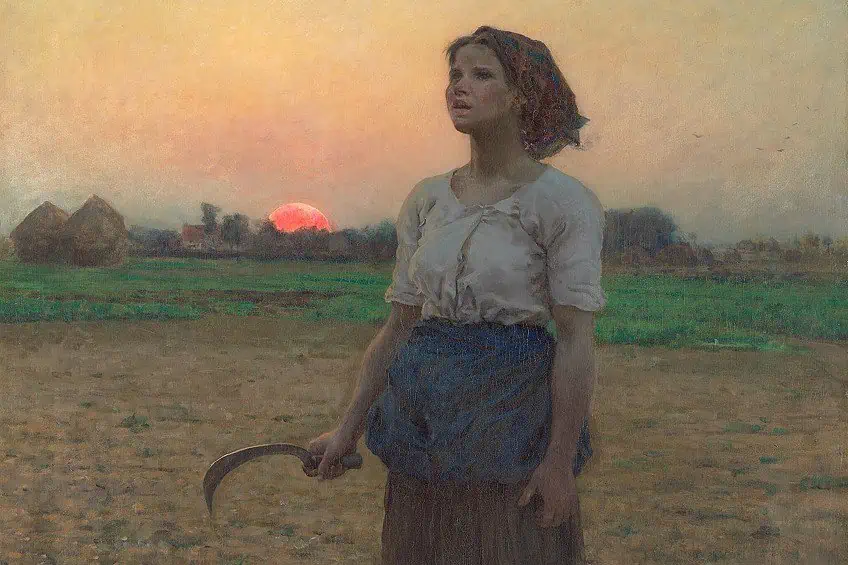Famous Realism Paintings – Capturing Reality in 12 Artworks
Realism artwork enabled artists to focus their artistic endeavors on subjects that had previously been overlooked by other genres and art styles. Realism paintings featured individuals of different social classes in everyday situations, which often portrayed the shifts in society brought about by the Commercial and Industrial Revolutions. Famous Realism artworks started appearing around 1850, after many painters of the time strove to depict life as it was rather than exaggerating scenes and incidents in a way that altered or distorted reality. Today, we will explore the most renowned Realism art examples as we count down our list of famous Realism paintings!
Exploring the Most Famous Realism Paintings
Realist painters saw their artwork as a way to educate the general public about many different societal circumstances and developments in culture that could have otherwise gone unnoticed. They rebelled against the Romanticism movement’s intensified emotionalism and exotic topics, which characterized French art and literature from the late 18th century onwards.
Rather than glorifying European life as it was at the time, they utilized their abilities to draw the attention of the general population to certain realities that would ultimately help bring about a shift in some aspects of society.
Social realism focused on depictions of the working class and regarded them with the same serious study as other social classes. Realism also tried to minimize artificiality in the portrayal of human emotions and interactions, therefore, sentimental or heroic representations were eschewed. Below, you will find our list of the most famous Realism artworks.
The Stone Breakers (1850) by Gustave Courbet
| Artist Name | Gustave Courbet (1819 – 1877) |
| Date Completed | 1850 |
| Medium | Oil on canvas |
| Dimensions (cm) | 165 x 257 |
| Current Location | Gemäldegalerie, Dresden, Germany |
After exhibiting his work at the Paris Salon in 1850, Courbet received a lot of criticism from art critics. This painting is credited with sparking the Realism movement in France and the rest of Europe because it was an obvious deviation from the long-held heritage of depicting figures and scenes in a way that venerated the social elite and their activities. It depicts two stone laborers with their backs to the observer, engaged in the arduous job of crushing huge stones down to workable gravel.
This was a particularly difficult profession, and many in the French upper class considered it as a vulgar representation of peasant existence undeserving of the close scrutiny of the upper class in Paris, who were completely inexperienced with physical labor.

The artist is thought to have painted the piece to call attention to the difficulties that many peasants in France faced during that period, while the opulent nobility were living a very different lifestyle. During the Second World War, this artwork was destroyed along with numerous other paintings. During the transit of these paintings to the castle of Konigstein near Dresden in 1945, the vehicle transporting them was attacked.
The Horse Fair (1855) by Rosa Bonheur
| Artist Name | Rosa Bonheur (1822 – 1899) |
| Date Completed | 1855 |
| Medium | Oil on canvas |
| Dimensions (cm) | 244 x 507 |
| Current Location | Metropolitan Museum of Art, New York City, United States |
Bonheur, who acquired the principles of art from her father, grew to fame because of her animal paintings. Her aesthetic remained firmly based on Realism throughout her career and her art was based on precise observation of nature along with her exceptional technical abilities. She adored animals, particularly horses, and her study of their nature and anatomy is evident in her works. This massive painting is considered her best work, but it is also out of the ordinary for her usual style.
Although the painting’s base is Realism, she handled her topic with a combination of Romanticism color and passion.

The painting is based on sketches she created while visiting the Paris horse market, where she sketched twice a week for around a year and a half before beginning the painting process. Women were seldom seen at such gatherings, so the artist disguised herself as a male to avoid drawing unwelcome attention while watching the fair parade. It received accolades when it was presented in the Paris Salon and was subsequently exhibited around the United Kingdom from 1855 to 1857.
The Gleaners (1857) by Jean-Francois Millet
| Artist Name | Jean-François Millet (1814 – 1875) |
| Date Completed | 1857 |
| Medium | Oil on canvas |
| Dimensions (cm) | 84 x 112 |
| Current Location | Musée d’Orsay, Paris, France |
Realist artists typically depicted ordinary life in French culture, where the movement fully took root. The famous Realism artist Jean-Francois Millet was most renowned for his ability to represent ordinary individuals performing regular tasks such as housework, working, or even socializing. This famous Realism artwork captures the essence of the Realism movement in a single canvas.
It is one of three pieces in a series that depicts female peasants going about their everyday lives – in this instance, they are gleaning, or collecting residual crops that are regarded as scraps by those who initially harvested the crop.

It depicts what is usually regarded as the lowest strata of society in France, and Millet’s artwork was heavily criticized by certain critics at the time because it depicted the exact opposite of what a lot of people in the art world saw as deserving of their attention. The painting’s dull colors appear to depict the monotonous aspect of these peasant women’s lives. Many noble French residents were generally unaware of the difficulties that ordinary people had to experience, and it was Realism art examples such as these that pushed the Realism movement into public awareness.
Olympia (1863) by Édouard Manet
| Artist Name | Édouard Manet (1832 – 1883) |
| Date Completed | 1863 |
| Medium | Oil on canvas |
| Dimensions (cm) | 190 x 130 |
| Current Location | Musée d’Orsay, Paris, France |
In 1865, when Edouard Manet debuted this work of art at the Parisian Salon, the audience was shocked. He purposefully defied artistic tradition by painting this work in an exceptionally flagrant new manner that signaled the starting point of the modernist era. Manet’s conscious choice of using a real-life model rather than a mythical, idealized heroine was among the most striking statements he made with this artwork. Victorine Meurent, an artist and muse who was a part of the Parisian art scene, served as the painting’s model.
Despite the fact that she was an artist, Manet wanted her to look like a high-class prostitute in this famous Realism artwork.
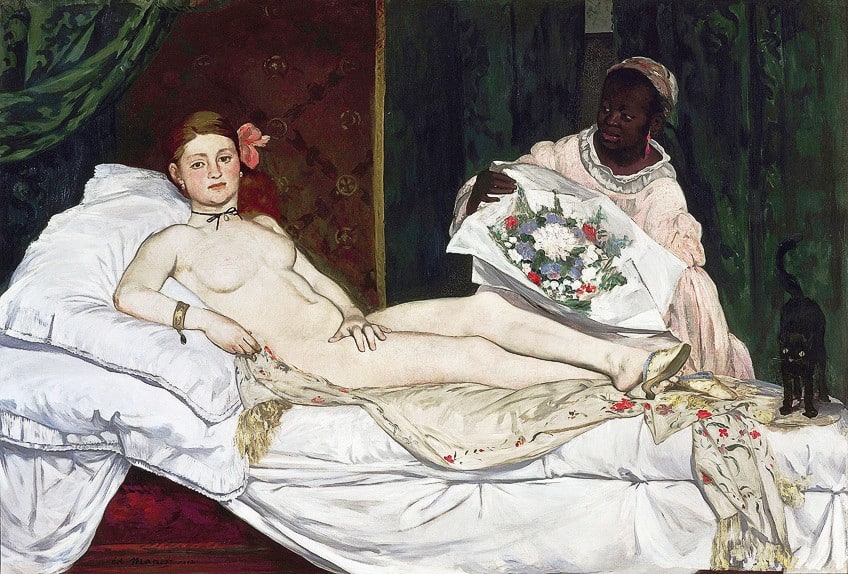
The black cat on the right is a well-known representation of sexual promiscuity, and the maid is clearly delivering a bunch of flowers from a customer. The maid contrasts with the naked model in several ways, including their differing skin color and the fact that one is dressed for work while the other is completely naked. Women working as prostitutes was common in Paris in the 19th century, but they performed a job that no one dared talk about, and it was very uncommon for a painter to depict it in such a blatantly obvious manner.
The Third-Class Carriage (1864) by Honoré Daumier
| Artist Name | Honoré Daumier (1808 – 1879) |
| Date Completed | 1864 |
| Medium | Oil on canvas |
| Dimensions (cm) | 65 x 90 |
| Current Location | Metropolitan Museum of Art, New York City, United States |
This painting exemplifies Daumier’s sympathy for the impoverished. Despite being a scathing caricaturist of politicians and the bourgeoisie, Daumier abandons the satire and paints a compassionate portrait of the impoverished. In the third-class carriage, a family sits together, curled in on themselves, secluded and occupied with their thoughts. Daumier aimed to depict the hardship of the working class by means of ordinary and quieter moments of their daily life rather than through drama. The hardship of their life may be seen in their attire, the fatigue of their postures, and their facial expressions.
Because this work is incomplete, the artist’s real intention remains unknown regarding his final color palette.

However, based on the browns that he used in the background and the different tones of black, brown, and green he used on the passengers’ attire, one may deduce that it is intended to be a somber color palette. The painting’s lighting provides an appealing and surprising contrast to the somber tone of the rest of the work. The artist employed economy of line as much as possible to make his drawings simple and strong, as seen in the mother’s hands, for instance. Even though they are only outlines, they are finely rendered.
The Elder Sister (1869) by William-Adolphe Bouguereau
| Artist Name | William-Adolphe Bouguereau (1825 – 1905) |
| Date Completed | 1869 |
| Medium | Oil on canvas |
| Dimensions (cm) | 130 x 97 |
| Current Location | Museum of Fine Arts, Houston, United States |
This famous Realism artwork depicts a female resting on a rock with a sleeping infant on her lap, with a peaceful country landscape in the background. Bouguereau’s daughter and son acted as models for this artwork, and the artist took considerable time in painting the children’s features and placement of their bodies so as to provide the most idyllic aesthetic possible.
The young girl is directly gazing at the observer, and the highly structured composition of the piece exemplifies the artist’s academic painting approach. The girl’s expression is one of grace and calm.
The Elder Sister (1869) by William-Adolphe Bouguereau; William-Adolphe Bouguereau, Public domain, via Wikimedia Commons
This, paired with the child napping soundly in her arms, contributes to the overall sense of calm of the work. The artwork was anonymously donated to the Museum of Fine Arts in Houston, Texas, in 1992, and it remains exhibited as a permanent highlight in their Arts of Europe department to this day. This work is not to be confused with another piece with the same title produced by the artist in 1864. Despite both these works sharing the same title and subject matter, the actual composition of each is distinctly different.
Whistler’s Mother (1871) by James McNeill Whistler
| Artist Name | James McNeill Whistler (1834 – 1903) |
| Date Completed | 1871 |
| Medium | Oil on canvas |
| Dimensions (cm) | 144 x 162 |
| Current Location | Musée d’Orsay, Paris, France |
Whistler created this work after returning from Paris, where he had been studying traditional art techniques at the Ecole Impériale. This piece is a portrait of his mother, created in 1871 while they were staying in London. It was believed that the artist’s original model was unable to attend the session, and it was at this point that he decided to make a painting of his mother. Before the production of this iconic artwork, there was quite a bit of experimenting with the composition.
Whistler intended for his mother to pose while standing up, but she found it too challenging. He was able to demonstrate his method of tonal arrangement and harmony in this work of art.
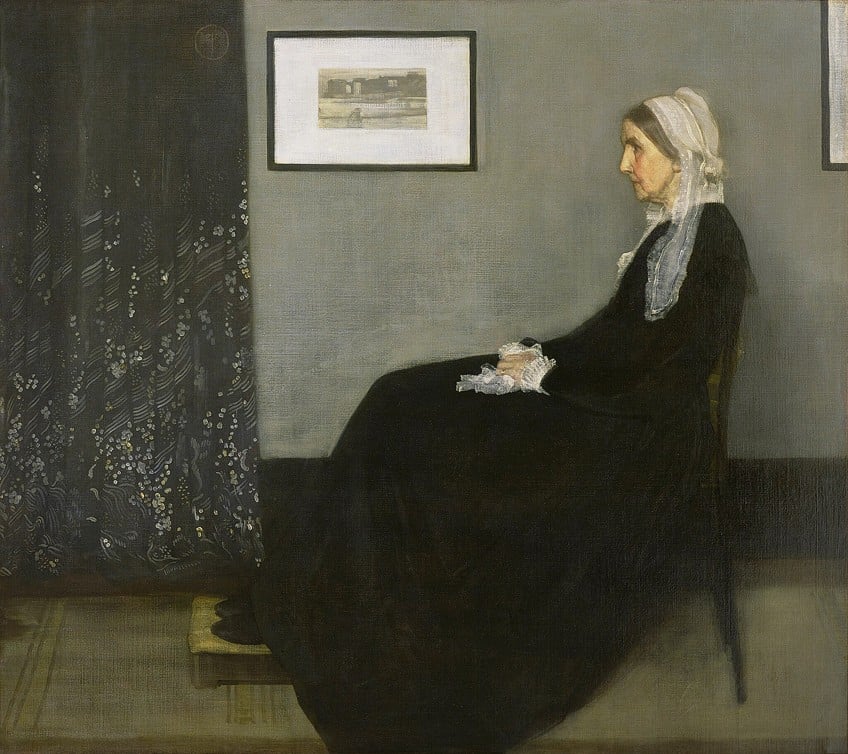
At first sight, the artwork appears somewhat simple. However, upon closer scrutiny, it displays a balance between the many forms present. While it is regarded among the most famous Realism paintings today, when this picture was created, several art critics had varying opinions on it.
Barge Haulers on the Volga (1873) by Ilya Repin
| Artist Name | Ilya Repin (1844 – 1930) |
| Date Completed | 1873 |
| Medium | Oil on canvas |
| Dimensions (cm) | 131 x 281 |
| Current Location | State Russian Museum, St. Petersburg, Russia |
Ilya Repin is credited with creating the Russian Realism movement during the later part of the 19th century. Repin is a well-known Social Realism artist who attempted to portray the everyday challenges of the average worker. This artwork exemplifies Repin’s efforts to draw attention to the predicament of the average dock worker and sailor in the major port cities surrounding the Volga River in that era. The artist produced this particular work after spending months sitting next to the Volga River, observing the boats and ships float by while the workers labored ceaselessly.
Repin is known in particular for his depiction of these laborers engaging in after-work leisurely activities like gamesmanship and drinking, which he perceived as a unique and distinctive sense of brotherhood among these working-class people.
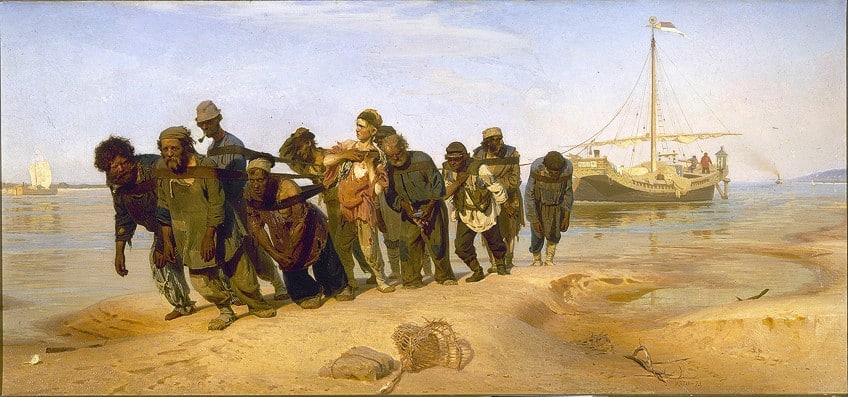
At the time, the artist was generally known for devotional paintings based on Biblical scriptures, therefore his abrupt move to producing Realism artwork was surprising to many people. The artwork features 11 men towing a barge to shore by means of ropes tied around their bodies. The juxtaposition of mechanical propulsion and human labor brings attention to the decline of these workers in the Industrial Revolution as the strength of their bodies was rendered redundant by the immense power of machines.
The Gross Clinic (1875) by Thomas Eakins
| Artist Name | Thomas Eakins (1844 – 1916) |
| Date Completed | 1875 |
| Medium | Oil on canvas |
| Dimensions (cm) | 240 x 200 |
| Current Location | Philadelphia Museum of Art, Pennsylvania, United States |
This painting, praised for its accurate realism, holds a significant position in the history of medicine. This is due to the fact that it honors the development of surgery as a profession and also because it depicts what a theater of surgery looked like in the 19th century. The artwork is based on a surgery that the artist personally witnessed in which the doctor operated on a young man for femoral osteomyelitis. The doctor is portrayed here performing a cautious procedure rather than the usual amputation that would have occurred previously.
The piece was critiqued for being somewhat grotesque yet it serves as one of the Realism art examples that embody the sense of realism and truth that is essential in the Realism movement.
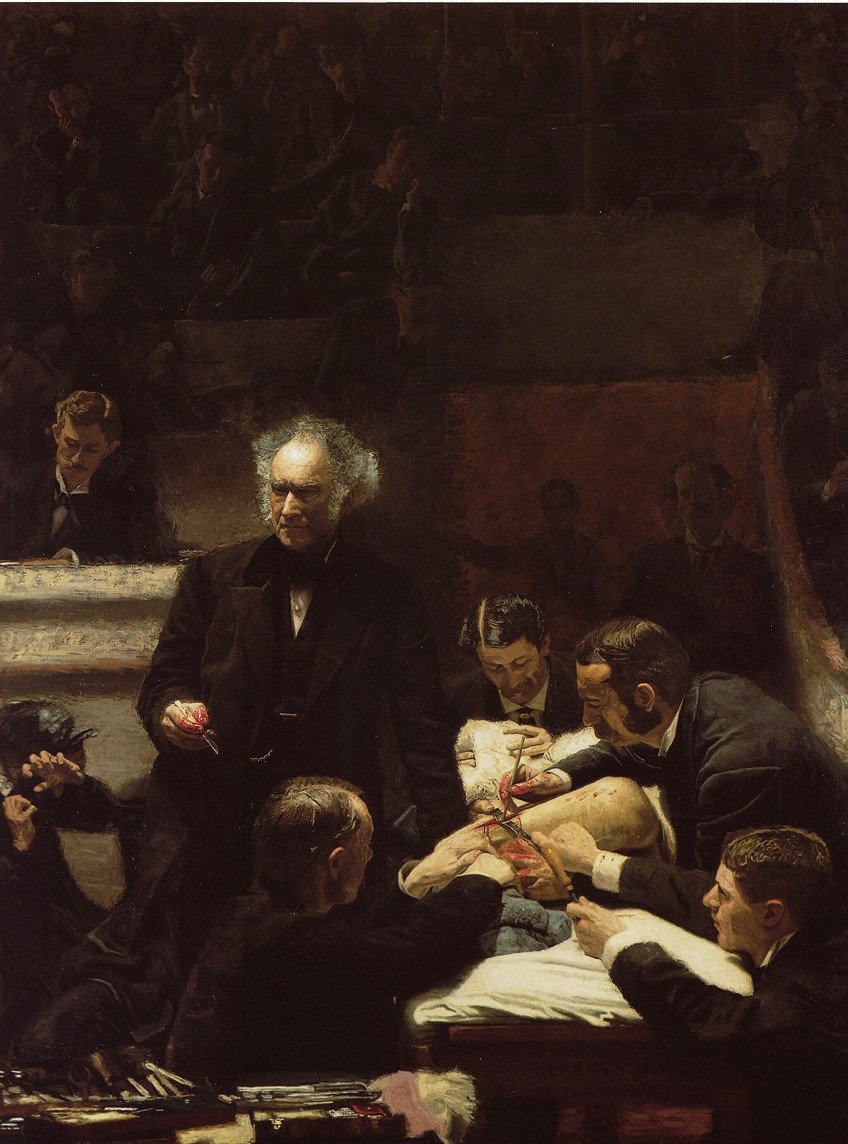
While the patient represented is presumed to be a teenage boy, the bare body is not entirely identifiable as being either a male or female. The inclusion of the distressed solitary woman visible in the middle of the painting, adds to the overall sense of drama and is possibly the patient’s mother. Her visible distress stands in stark contrast to the calm and collected gentlemen who surround the patient.
Song of the Lark (1884) by Jules Breton
| Artist Name | Jules Breton (1827 – 1906) |
| Date Completed | 1884 |
| Medium | Oil on canvas |
| Dimensions (cm) | 110 x 85 |
| Current Location | Art Institute of Chicago, Illinois, United States |
Breton’s works are highly influenced by the French countryside, and his embrace of traditional painting methods helped him become one of the key communicators of the beauty of rural living. Jules Breton’s painting is regarded as one of the most iconic works of French Realism and garnered widespread recognition as a less aggressive, more broadly accepted form of Realist painting.
The lark is generally a sign of sunrise, therefore the artist’s late-century Realism contains a sense of poetic symbolism.

While the sun rises on the horizon, a peasant stands in the center of a field, carrying a scythe. The colors of the sky provide a lovely backdrop for the tenacious, barefoot laborer. The artist’s exaltation of labor made the artwork very admired in his own country as an icon of French resilience. His depictions of peasants working in the fields became so famous that he had many of them printed and on occasion painted copies. In his own day, he was immensely successful, displaying countless works at Salons. He was considered an acclaimed artist of his day in England, France, and the United States.
Nighthawks (1942) by Edward Hopper
| Artist Name | Edward Hopper (1882 – 1967) |
| Date Completed | 1942 |
| Medium | Oil on canvas |
| Dimensions (cm) | 84 x 152 |
| Current Location | Art Institute of Chicago, Illinois, United States |
The Realism movement lasted more than a century, but the general themes of this style remained mostly unchanged. The famous Realism artist Edward Hopper is possibly most well-known for this work of art, which is often regarded as among the most iconic American works ever created. It represents a typical inner-city American scene from the 1940s. This was a decade when industrialization revolutionized daily life for everyone in the industrialized nations and depicts the repercussions of a rapidly changing society. It depicts three customers seated in a late-night diner, with one server busy doing his job.
The stark contrast of the brilliantly illuminated inside of the diner against the dark, bland street corner outside was an apt representation of how urban city living crowded people closer to one another, yet ironically, they had never been more apart socially.

The angle from which it was painted also enables Hopper to present the people in a number of profile and frontal angles, reinforcing the impression that no person is actually interacting with another. It represents the struggles of the American people during one of the country’s darkest periods. When it was finally completed, this Realism artwork was purchased by the Art Institute of Chicago, where it is still exhibited today, drawing thousands upon thousands of visitors every year.
Christina’s World (1948) by Andrew Wyeth
| Artist Name | Andrew Wyeth (1917 – 2009) |
| Date Completed | 1948 |
| Medium | Oil on canvas |
| Dimensions (cm) | 82 x 121 |
| Current Location | Museum of Modern Art, New York City, United States |
Polio affected many people in America throughout the mid-20th century. Many art historians believe the person in this painting represents one of the many people who suffered from this devastating malady, for which there was no treatment at the time. In this famous Realism artwork, a woman sits in the long grass of a hillside near a farmhouse.
It depicts the girl trying to crawl to the farmhouse in the distance – a harsh reality that many suffering from polio had to contend with in those days.
Many believe the girl in the painting is based on a friend of the artist, Anna Christina Olson, who struggled with a degenerative muscle condition that made her unable to walk. He met her for the first time in 1939 and was introduced by Betsy James, the lady who would become his wife and whose farm was adjacent to the Olson’s farm. The artist was inspired to create this painting after observing Christina crawling up a hill after harvesting vegetables from their garden. Christina’s facial features are hidden from the viewer, which is known as a “lost profile”.
Following the 1848 Revolution, which secured the right to work in the country, the Realism movement introduced the concept of ordinary and working-class individuals, contemporaneous locations, and ordinary scenes as viable subject matter. These Realist painters rejected the standards of Romanticism, a genre characterized by an intensified sense of emotion. This was replaced with a more down-to-earth portrayal of the peasants and working-class citizens that had not ever been considered by the elite, let alone regarded as worthy of depiction in art. This led to the emergence of famous Realism art examples, the likes of which were discussed above.
Frequently Asked Questions
What Is Realism Artwork About?
Realism is often regarded as the birth of contemporary art. This is owing to its view that ordinary life and contemporary culture were appropriate themes for art. On a philosophical level, Realism supported modernism’s progressive goals, pursuing new truths by means of the examination and overturn of established values and belief systems. Whereas before, art had concerned itself with subjects that were aesthetically pleasing, Realism artists portrayed the world around them as it was, shedding light on the hardships experienced by the poor and working class.
Who Are the Most Famous Realism Artists?
Gustave Courbet is widely regarded as the father of Realism, having created the framework for the genre in the 1840s by depicting laborers and peasants. Jean-François Millet, as with Courbet, chose to depict working-class individuals in his works of art. Rosa Bonheur specialized in animal portraiture. Given her fascination with the countryside, many of her works of art are set in fields, farms, and other rural scenes.
Jordan Anthony is a Cape Town-based film photographer, curator, and arts writer. She holds a Bachelor of Art in Fine Arts from the University of the Witwatersrand, Johannesburg, where she explored themes like healing, identity, dreams, and intuitive creation in her Contemporary art practice. Jordan has collaborated with various local art institutions, including the KZNSA Gallery in Durban, the Turbine Art Fair, and the Wits Art Museum. Her photography focuses on abstract color manipulations, portraiture, candid shots, and urban landscapes. She’s intrigued by philosophy, memory, and esotericism, drawing inspiration from Surrealism, Fluxus, and ancient civilizations, as well as childhood influences and found objects. Jordan is working for artfilemagazine since 2022 and writes blog posts about art history and photography.
Learn more about Jordan Anthony and about us.
Cite this Article
Jordan, Anthony, “Famous Realism Paintings – Capturing Reality in 12 Artworks.” artfilemagazine – Your Online Art Source. November 16, 2023. URL: https://artfilemagazine.com/famous-realism-paintings/
Anthony, J. (2023, 16 November). Famous Realism Paintings – Capturing Reality in 12 Artworks. artfilemagazine – Your Online Art Source. https://artfilemagazine.com/famous-realism-paintings/
Anthony, Jordan. “Famous Realism Paintings – Capturing Reality in 12 Artworks.” artfilemagazine – Your Online Art Source, November 16, 2023. https://artfilemagazine.com/famous-realism-paintings/.


